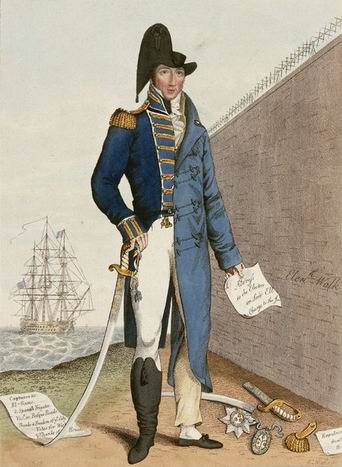
Thomas Cochrane became one of the most celebrated naval heroes of his day. Napoleon dubbed him Le Loup des Mers (literally ‘The Wolf of the Seas’) and his career inspired C.S. Forrester’s fictional hero Horatio Hornblower and Patrick O’Brien’s Jack Aubrey. He was an inspiring leader and innovator, yet his political naivety and radical outspokenness almost cost him everything.
Thomas Cochrane was born at Annsfield, near Hamilton, in Scotland in 1775, the son of Archibald Cochrane, 9th Earl of Dundonald. He joined the navy at the age of 17 on the outbreak of the French Revolutionary Wars in 1793 as a midshipman serving in HMS Hind, a frigate commanded by his uncle, Captain Alexander Cochrane.
In less than three years Cochrane was promoted lieutenant and then in 1800 promoted to commander, taking command of the brig-sloop HMS Speedy later that year. In his 13-month cruise aboard the Speedy, Cochrane captured, destroyed or drove onshore over 50 enemy vessels. His most notable exploit was the capture of the Spanish xebec frigate El Gamo, on 6 May 1801. El Gamo carried 32 guns and 319 men, compared with Speedy’s 14 guns and 54 men. Cochrane flew an American flag and approached so closely to El Gamo that its guns could not depress to fire on the Speedy’s hull. The Spanish tried to board and take over the ship but each time they massed to attack, Cochrane pulled away briefly and fired on the concentrated boarding parties with his ship’s guns. Eventually, Cochrane boarded El Gamo, despite being outnumbered about five to one, and captured her.

HMS Speedy captures the frigate El Gamo
Given command of the new frigate HMS Pallas (32) in 1804, he cruised the Azores and French coast capturing and destroying several Spanish and French vessels. Transferred to HMS Imperieuse (38) in August 1806, he returned to terrorizing the French coast. Now a master of coastal warfare, Cochrane frequently led cutting out missions to seize enemy ships and captured French coastal installations.
But in 1809, his star came crashing down.
At the Battle of the Basque Roads in April of that year, Cochrane’s initial attack using fire ships greatly disrupted the French fleet. But his commander, Lord Gambier, failed to effectively follow up to completely destroy the enemy. Elected to Parliament in 1806, Cochrane had sided with the Radicals and frequently criticized the prosecution of the war and campaigned against corruption in the Royal Navy. These efforts had lengthened his list of enemies in higher office. Publically criticizing Gambier in the wake of Basque Roads, he alienated many more senior members of the Admiralty. Their retribution was swift and Cochrane was removed from his command and denied any other. Though loved by the public, he became isolated in Parliament as he angered his peers with his outspoken views.
In 1814, his fall was made humiliatingly complete. Cochrane was implicated in a stock market fraud based on the rise of government stock following false rumours of Napoleon’s death. In June with five others he was brought to trial for fraud in a trial presided over by the harsh, overbearing and Radical-hating Lord Ellenborough. The outcome was never going to be in question and, even though the prosecuting counsel admitted the evidence was circumstantial, Cochrane was found guilty.

An 1815 caricature “Things as they have been. Things as they are now.” depicting Cochrane as the naval hero on the left while the right side shows him as the disgraced and imprisoned civilian
Cochrane was sentenced to 12 months imprisonment, fined £1,000 and was ordered to stand in the pillory opposite the Royal Exchange for one hour. In subsequent weeks, he was dismissed from the Royal Navy by the Admiralty and expelled from Parliament following a motion in the House of Commons. Cochrane was further humiliated by the loss of his knighthood in a degradation ceremony at Westminster Abbey. His banner was taken down from the Chapel of Henry VII in the Abbey and physically kicked out of the chapel and down the steps outside.
Persona non grata in his own country, Cochrane elected to sell his military services overseas. He went on to command the Chilean, Brazilian and Greek navies, helping them fight for independence. In 1831 he succeeded to his father’s title, becoming 10th Earl of Dundonald.
Returning to Britain, Cochrane was finally pardoned in May 1832 at a meeting of the Privy Council. Though restored to the Navy List with a promotion to rear admiral, he refused to accept a command until his knighthood was returned. This did not occur until Queen Victoria reinstated him as a knight in the Order of Bath in 1847. Now a vice admiral, Cochrane served as commander in chief of the North American and West Indies station from 1848-1851. Promoted to admiral in 1851, he was given the honorary title of Rear Admiral of the United Kingdom three years later. Troubled by kidney stones, he died during an operation on October 31, 1860.
Cochrane was buried in the central part of the nave of Westminster Abbey. The inscription, written on his tomb by Sir Lyon Playfair, reads:
“HERE RESTS IN HIS 85th YEAR THOMAS COCHRANE TENTH EARL OF DUNDONALD BARON COCHRANE OF DUNDONALD OF PAISLEY AND OF OCHILTREE IN THE PEERAGE OF SCOTLAND MARQUESS OF MARANHAM IN THE EMPIRE OF BRAZIL G.C.B. AND ADMIRAL OF THE FLEET WHO BY THE CONFIDENCE WHICH HIS GENIUS HIS SCIENCE AND EXTRAORDINARY DARING INSPIRED, BY HIS HEROIC EXERTIONS IN THE CAUSE OF FREEDOM AND HIS SPLENDID SERVICES ALIKE TO HIS OWN COUNTRY GREECE BRAZIL CHILI AND PERU ACHIEVED A NAME ILLUSTRIOUS THROUGHOUT THE WORLD FOR COURAGE PATRIOTISM AND CHIVALRY. BORN DEC 14th 1775. DIED OCT. 31st 1860”
